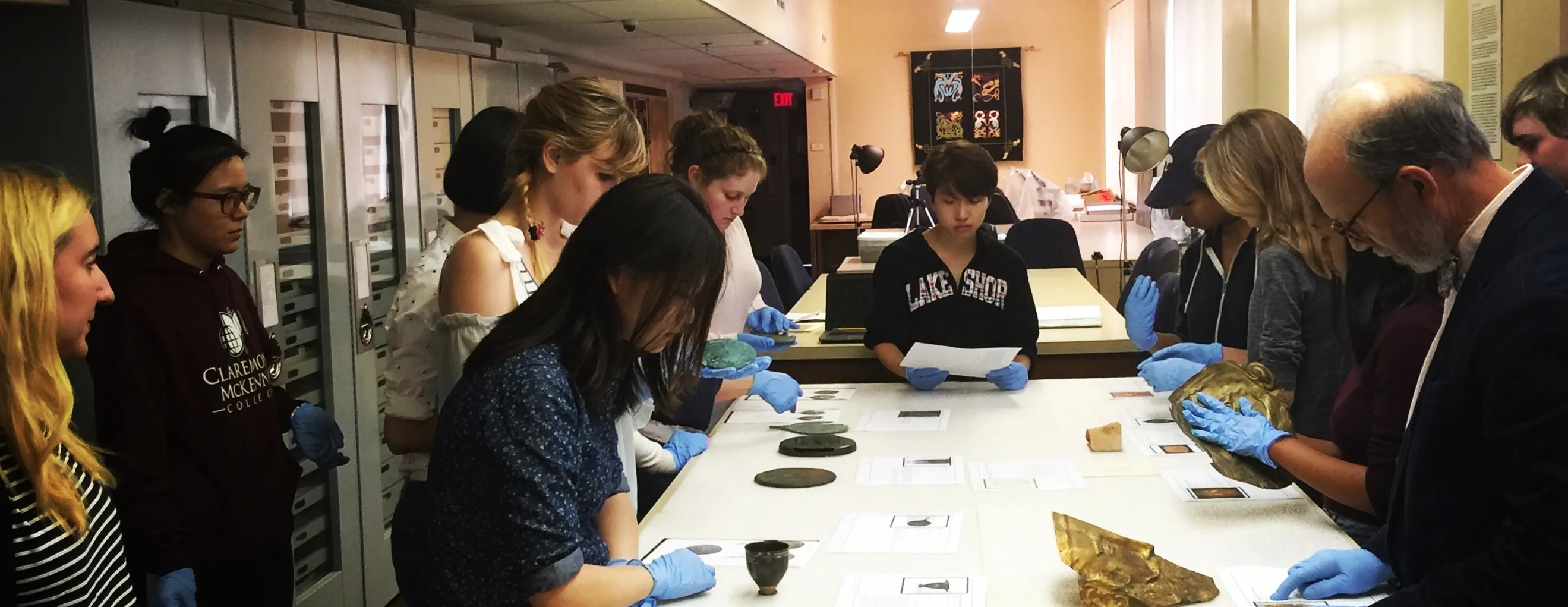
History of Special Collections at Bryn Mawr
Introduction
Special Collections manages Bryn Mawr College’s holdings of rare books, manuscripts, art works, cultural artifacts, rock and mineral collection, and the College’s archives within the framework of the overall College mission. Special Collections promote teaching and learning with the collections through class visits, research project support, internships, public programs, and exhibitions. The department offers opportunities for the college community to engage actively and critically with primary resources and to conduct original research, thereby fostering inter-disciplinary materiality study, visual literacy, and the preservation and discovery of diverse, non-traditional narratives.
Understanding how Special Collections came together aids Special Collections staff and patrons in using collections. Material in Special Collections ranges widely by period and region and includes natural history objects, works of art, archaeological and ethnographic artifacts, photographs, audio-visual materials, archival documents, books, manuscripts, scientific instruments, and more. These objects were primarily given to the College by faculty, alumni, and donors and represent their individual areas of research and/or collecting interests. Please see our Collection Management Policy for more information on current Collection Development priorities.
First Collections and Major Gifts
Some of the first educational and decorative resources acquired by the college are now located in Special Collections. Many of these were purchased by Dr. M. Carey Thomas, first as Dean and then as President, and her partner, Mary Garrett. They collected furniture, paintings, prints, and objects for The Deanery—their home—as well as documentary photographs, prints, and plaster casts, which were used in curriculum and displayed in Taylor Hall and Old Library.
These items were supplemented by an assemblage of Greek, Roman, and Egyptian antiquities collected in the early 20th century by the first faculty members of the Department of Art and Archaeology. By the 1940s, major gifts of prints, drawings, and paintings had been received from Professor Howard L. Gray, Roy R. Neuberger, and various other faculty and alumnae. The Ella Riegel Memorial Collection for Mediterranean Archaeology was established circa 1940, and ethnographic collections were established by Professor Frederica de Laguna in the 1950s. These collections of art and artifacts became formalized as the College Collections Department within the Library in 1980.
Rare Book & Manuscripts Collection
The Rare Book & Manuscripts Collection was formally established in 1940, and included the classical library of Professor Hermann Sauppe, purchased by Mary Garrett in 1894. Additional rare book and manuscript collections were built through donations from the College’s graduates and other friends over the years, including Ethelinda Schaeffer Castle (Class of 1908), Howard Goodhart and his daughter Phyllis Goodhart Gordan (Class of 1935), Ellery Yale Wood (Class of 1952), and Philadelphia book collector Seymour Adelman. Adelman also endowed a fund for the purchase of rare books and manuscript materials. This endowment permits us to continue to add to the collections.
The College Archives
The College Archives was established in 1980. The college’s historical records were transferred from administrative offices to the Archives after that date. The College Archives holds more than 3 million items and the collection spans over 2,000 linear feet of records. These records primarily document administrative decisions and campus life, from 1885 to today. They include scrapbooks, diaries, photographs, the records of past Presidents, the Board of Trustees, faculty, and material which contextualizes our Art & Artifact objects. We encourage researchers to consider both the presence and absence of records in our holdings as we develop a more inclusive and intersectional representation of Bryn Mawr College and its communities.
Art & Artifacts Collection
The Art & Artifacts Collection was united administratively with the Rare Book & Manuscript Collection as the Special Collections Department in 1999, but only physically brought together in 2011 when the staff and most of the collections were consolidated in the Eva Jane Romaine Coombe ’52 Special Collections Suite in Mariam Coffin Canaday Library. As of 2019, there are over 50,000 art and artifact objects in the collection, supporting teaching, advanced research, and exhibitions across numerous fields.
Rock & Mineral Collections
Established by Professor Florence Bascom, founder of the Geology Department, from specimens she collected herself, the Bryn Mawr College Rock & Mineral Collection has grown through significant donations by Theodore D. Rand in 1903 and George Vaux, Jr. in 1958, among others. The three core collections (Bascom, Rand, and Vaux) comprise specimens that were collected in the late 1800s to early 1900s, with the remainder representing specimens collected from approximately 1970-1990. The collection spans more than 90 countries, all 50 U.S. states, and more than 1,000 individual mineral species. For context, more than 90% of Earth’s crust is composed of just 50 mineral species; the Bryn Mawr Collection houses an astonishing diversity of mineral specimens.
